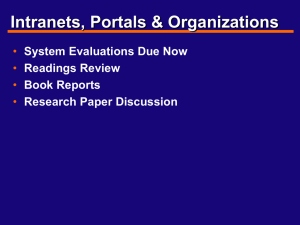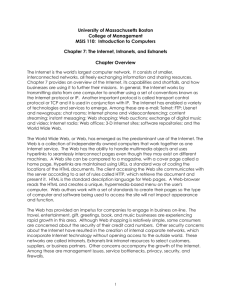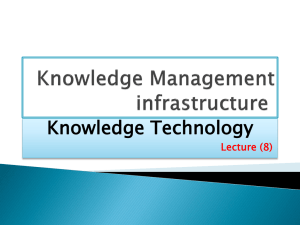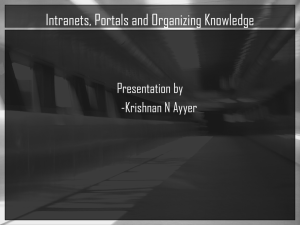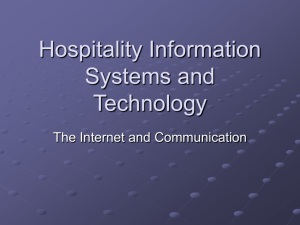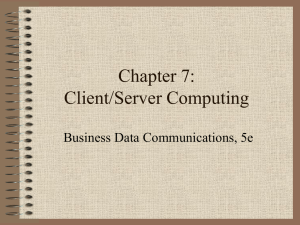Intranets and Knowledge Organization Thomas P Kiehne 25 March 2004
advertisement
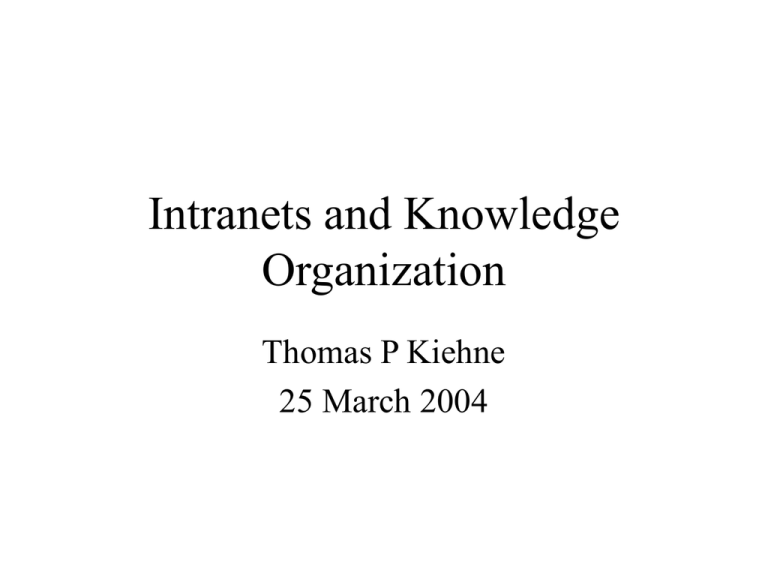
Intranets and Knowledge Organization Thomas P Kiehne 25 March 2004 Agenda • Definitions • Examples • Review of Literature Definitions • Brown & Duguid: “Intranets help present and circulate boundary objects” • Choo, Detlor, & Turnbull: “Intranets… support the creation, sharing, and use of knowledge” • Ginsburg & Kambil: “Intranet[s] facilitate distributed document publishing” Definitions • Stenmark: “Intranets are organizational restricted” • Detlor: “Intranets… are private, internal Web-based networks usually restricted to organizational participants only” • Abraham (1998): “a set of applications built on an internet-enabled infrastructure meant for internal use only by employees of a single organization” Working Definition • Secure access via common Internet protocols (HTTP) – Local access via firewalls / local area networks – Remote access via virtual private networks or password restriction • Restricted to an organization • Used for content aggregation, communications, and collaboration Examples • Intranets.com (via Keller-Williams Realty) – Service provider • Fosforus, Inc. – Custom-built (and in-progress) solution • UT Direct • BlackBoard Review of Literature • Brown & Duguid (1998) Organizing Knowledge • Choo, et al. (2000) Information Seeking and Knowledge Work on the WWW, ch. 4 • Ginsburg & Kambil (1999) Annotate • Stenmark (2000) The Creative Intranet • Liongosari, et al. (1999) In Search of a New Generation of KM Applications • Detlor (2000) The Corporate Portal as Information Infrastructure Organizing Knowledge • A response to the opinion that new technologies will dissolve the traditional organization – Economic view posits that transaction costs due to communications friction hold a firm together – Reference to Toffler: “The Third Wave” • Knowledge also defines the firm – Applies to all types of industries, not just information – Marketers might add: what about “brand” or “image” Organizing Knowledge • Knowledge is generated by communities of practice, which are social, often informal, organizations • Communities of practice organize around knowledge (“know-how”) sharing – Often cross-functional; “productive tension” or “creative abrasion” • The challenge lies in making tacit / existing knowledge coherent and available Organizing Knowledge • Warns against technological determinism: improved search and retrieval (i.e.: better Intranets) will improve knowledge transfer • Knowledge is not easily commodified, as in the market model, so retrieval is only part of the issue Organizing Knowledge • Organizations excel in hierarchy, which helps move “indivisible” knowledge, but discourages the synthesis of competencies on different levels – R&D doesn’t work with the factory workers or management… • Divisions between communities tend to foster innovation as well as isolation – University campus example Organizing Knowledge • Knowledge travels more easily between (like) organizations than it does internally – Presents an intellectual property challenge (copyright, patents, trade secrets) – Business practices become public domain by their public use Organizing Knowledge • Social Strategies for Knowledge Dissemination (Star & Griesemer) – Translation (framing one community’s interests into another’s perspective) – Brokering (bridging internal communities) – Boundary Objects (objects, technologies, or techniques that are used differently but forge links between communities) • Intranets help present and circulate boundary objects Information Seeking and Knowledge Work • Three-tiered model for Intranet design • Information ecology of an organization: – Organizational mission and the role information plays – Intranet’s goals and how they help the mission – Information management plans and policies – Information culture in terms of sharing information Information Seeking and Knowledge Work • Information ecology (contd.) – Information politics – Physical setting and its effect on information transfer – Information staff and their relationships to other staff and management – Information handling (e.g.: records and archives) Information Seeking and Knowledge Work • Information behaviors: user’s needs and problems • Value-Added Processes – Support the information needs of users – Design services to fit the information ecology – Provide a unified information space Information Seeking and Knowledge Work • Value-Added Processes (contd.) – Add value by facilitating the sharing, conversion, and combined use of the organization’s tacit and explicit knowledge – Support sense-making and decision making processes • For example… • Intranet design must be flexible and open to accommodate changes in the organization Information Seeking and Knowledge Work Information Seeking and Knowledge Work • Design principles: – Analyze the organization’s information ecology – Identify the typical problems and associated problem dimensions experienced by major sets of users – Analyze the information behaviors of these sets of users by concentrating on typical problem resolutions – Create value-added processes that enhance the information ecology and help resolve problems Annotate • Web-based business practices expose process knowledge to competitors, making “behind the scenes” processes more valuable (see also Brown & Duguid) • Knowledge transformation processes (Nonaka) – – – – Socialization: tacit to tacit Internalization: explicit to tacit Externalization: tacit to explicit Combination: explicit to explicit Annotate • Knowledge Management Support Systems (KMSS) – Data warehouse / database(s) – Search and discovery mechanisms – Knowledge representation via ontologies (precoordination vs. post-coordination) – Quality control (authorization, review, etc.) – Visualization techniques Annotate • System traversal – Front end: Query layer – Array of hyperlinks: Retrieval layer – Core documents: Document layer • Most systems do not maintain state across these layers for different users – Path to discovery – Reasons for search and selection Annotate • Annotate: a tool developed to provide appraisal and recommendation of documents • KM policies to support annotation – Incentives for annotations (cooperation dynamics) – Allow anonymity (identity and risk) – Annotator controls (authentication, limited population) The Creative Intranet • Organizational knowledge is created through a continuous and dynamic interpersonal interaction between tacit and explicit knowledge (Nonaka & Takeuchi) – The “Knowledge Spiral” • Creative acts are unplanned and cannot be forced or predicted, but can be promoted The Creative Intranet • Paraphrasing and modifying principles by Robinson and Stern: • “No Preconceptions Principle” – Alignment towards goals increases creativity, but may also be limiting • “Skunk Works” – Unanticipated activity often begins as an unofficial task The Creative Intranet • “Serendipity” – An accident is only useful if someone realizes its potential – Encourage experimentation; create redundancy across work functions • “Diverse Stimuli” – Expose employees to new input; “kaleidoscopic thinking” – Step back from the problem The Creative Intranet • “Communication” – Horizontal and vertical information sharing – Informal networks; encouragement to ask for help • “Trust and Reciprocity” – If the future is sufficiently important relative to the present, mutual cooperation can be established (see also Rheingold) The Creative Intranet • “Intrinsic Motivation” – Not bribery (Soviet example) • “Rich Information Provision” – Browsing and IR techniques – Diversity of representations (for a multiplicity of cognitive approaches) • How about constraints? – Adversity breeds creative solutions New Generation of KM Applications • Information must be presented beyond a list of documents – But what isn’t, aside from alternate visualization techniques, perhaps? – To the point: summary and analysis • Developed data mining techniques for Lotus Notes systems at Andersen Consulting: Knowledge eXchange (KX) – Used to find documents and SMEs New Generation of KM Applications • Problems encountered: – Consistency and structural problems with Notes; not relational – Data representation: borrowed “cleansing” techniques from Knowledge Discovery in Databases (KDD, Fayyad, et al.) New Generation of KM Applications • Data mining applications based on relational data model: • Biography Generator – Summarizes author information based on documents in system • Rate of Absorption: – Identifies users and authors of documents within (defined?) subject areas – Trends over time New Generation of KM Applications • Old Boys Network – Who knows who internally based on authorship and discussions – Does not evaluate email or voice data • Communities of Practice – Social network: defines groups by document involvement in specific subject areas New Generation of KM Applications • Related Subject Areas – Relates subject areas to each other by reference or association – Analyzes shift in subject trends over time – Assumes that document creation is indicative of a work continuum • Suggested Reading – Based on use of documents and group affiliations The Corporate Portal as Information Infrastructure • Corporate portal – Shared workspace, similar to Intranets – Differ in that they are a directory of information available elsewhere, not a stand-alone source – Early example: MyYahoo! – “All the rage” in the late ‘90s The Corporate Portal as Information Infrastructure • Portal characteristics: – Organizes information for users – Platform independent Web interface – Widely accessible (within the specific security regime) • Three components: – Content space – Communication space – Coordination space The Corporate Portal as Information Infrastructure • Value-added model for systems development (Taylor) – Attempts to understand the criteria by which users will judge information to be valuable • Information Use Environment (IUE) – – – – Settings: physical environment, attitudes Sets of people in these settings Problems they face Problem resolutions The Corporate Portal as Information Infrastructure • Information Ecology (Davenport) – Focus on uses as well as production and distribution • Components: – – – – – – Strategy Politics Behavior Staff Processes Architecture The Corporate Portal as Information Infrastructure • Behavioral / Ecological design framework – Based on Taylor and Davenport – See also Choo, et al. • Information Ecology -- Value-Added Processes -- Information Behaviors The Corporate Portal as Information Infrastructure Summary • “Build it and they will come” is not a reasonable design strategy • Users and their information needs are central to design
